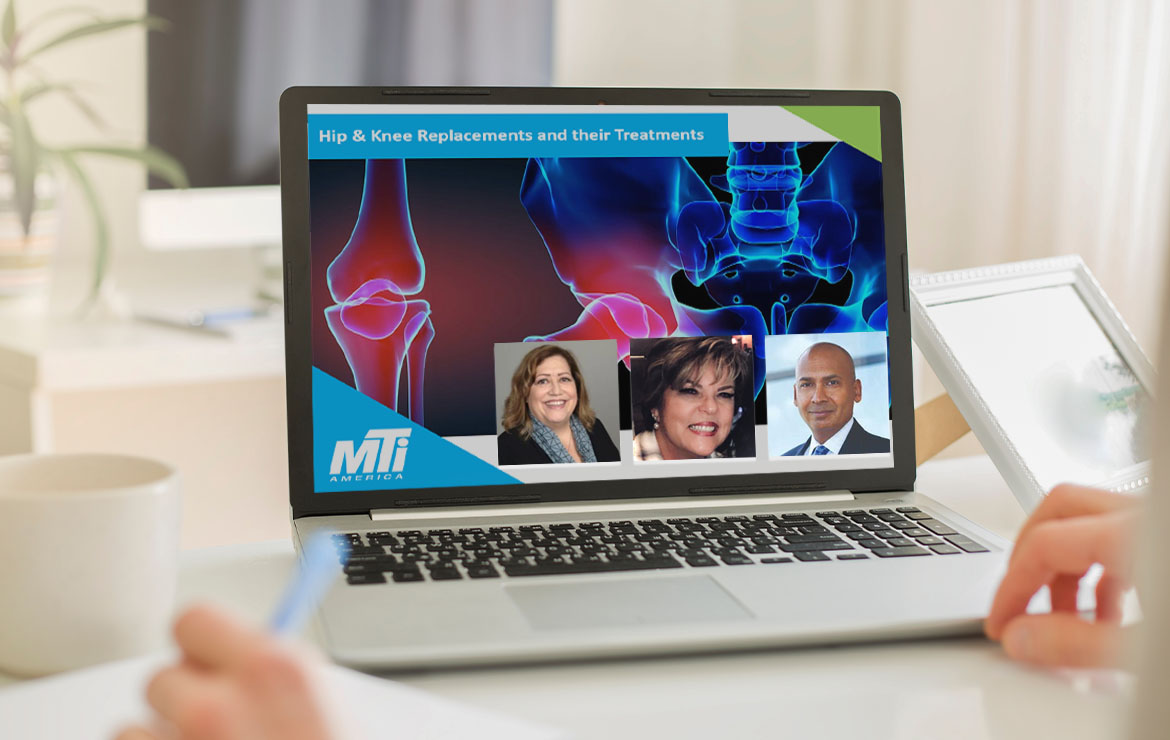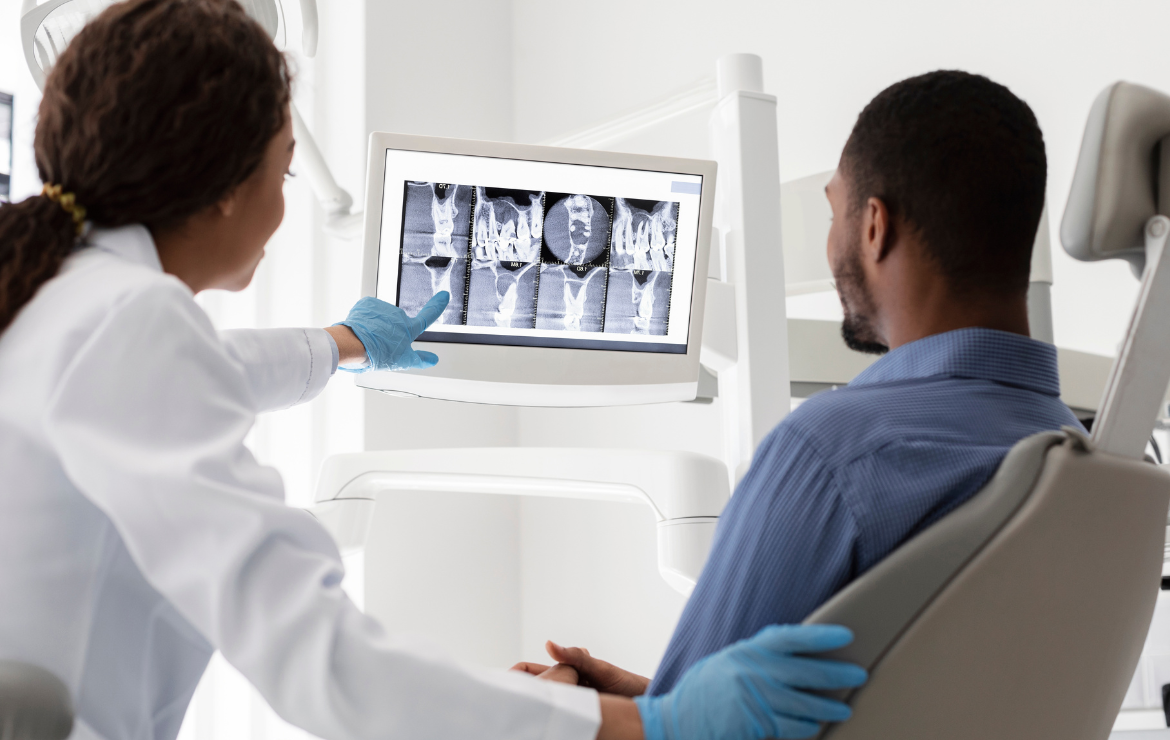Highlights From Knee and Hip Treatments Webinar

MTI America’s Laura Gorman hosted a webinar on March 30th, 2023, with Dr. Gupta and Susan Emerson which focused on hip and knee injuries. Dr. Gupta is an orthopedic surgeon specializing in hip and knee replacements at Peachtree Orthopedics where approximately 10-15% of cases are work-related. Susan Emerson is the former General Manager of Delta Air Lines Workers’ Compensation and Disability division.
Knees
Dr. Gupta kicked us off with work-related knee injuries and noted the most common causes are repetitive use, slips, trips, and falls, blunt trauma, and underlying pre-existing medical conditions or personal injury (arthritis, prior injury or surgery). In his experience, the pre-existing arthritis is the most common with an injury at work.
Knee arthritis is inflammation of the knee joint and in layman’s terms, it’s worn out cartilage. The most common causes of knee arthritis include:
- Osteoarthritis – wearing out of the cartilage.
- Inflammatory arthritis – auto-immune conditions such as RA and Lupus.
- Septic arthritis – infection in a native joint leading to cartilage destruction.
- Post-traumatic arthritis – an injury or fracture causing damage to the joint.
- Deformities – leading to premature wear of cartilage – typically congenital or developmental.
We learned x-rays are an inexpensive and easy way to take a look at the knee. Dr. Gupta showed us the difference between a “normal knee” x-ray and a patient with osteoarthritis. Specifically, he demonstrated how he utilized Fairbanks’ changes to look for 4 things on the osteoarthritis x-ray which include joint space narrowing, subchondral sclerosis, peripheral osteophytes (bone spurs), and subchondral cysts.
Dr. Gupta went on to describe some of the differences in inflammatory arthritis, septic arthritis, and post-traumatic arthritis. The example shown for post-traumatic arthritis was jaw-dropping as the patient fell from an 8′ ladder and required a knee replacement.
Hips
The webinar then transitioned to focus on hip conditions and hip pain. The causes are repetitive use, blunt trauma, slips, trips, and falls, and underlying pre-existing medical conditions or personal injury (arthritis, prior injury, or surgery which are the most common in Dr. Gupta’s practice). In addition to the types of arthritis reviewed above, we also explored avascular necrosis (AVN), which happens when the blood supply to the bone and cartilage is disrupted.
Dr. Gupta shared several patient x-rays demonstrating the various types of hip arthritis. He shared stories about the patient and how the injury occurred. Some x-rays could clearly be compensable under workers’ compensation, and other cases were not so clear.
Compensability
All agreed the topic of compensability can be challenging, but it was clear from the discussion that subjective and objective findings must be used together. Dr. Gupta encouraged adjusters and physicians alike to take a solid patient history (patient information, injury or insidious onset, types of symptoms, the effect on function, and quality of life).
In addition to the patient’s history, the patient receives a physical exam to inspect, look for deformities, explore ROM, perform provocative tests, etc. And other objective findings come from x-rays and/or more advanced imaging options like an MRI or CT scan.
Dr. Gupta said, “99% of the time, the patient says my knee didn’t hurt before the work accident.” He stressed that having prior medical records is the single best way to determine whether or not the injury is pre-existing or if it was asymptomatic before the work injury.
Like claims professionals, physicians are forced to have difficult conversations when there are compensability issues. Better outcomes often come when the patient trusts the doctor and when the doctor can explain why it would be best to put something under their personal health insurance when it’s not work-related.
The presenters also touched on return-to-work and impairment ratings which are unique to the claim and jurisdiction, respectively. As a general rule of thumb, a good knee replacement has an impairment rating of 15% for the whole person and 37% for the extremity.
The final takeaway was for claims professionals and physicians alike. The presenters said to be sure to understand the jurisdiction because each state has its own various rules and regulations on how to address pre-existing conditions. Some states have a clear path to assessing pre-existing conditions, while others can be vague.
Diagnostic Solutions From MTI America
At MTI America, our goal is to quickly get your injured worker the right image the first time, and this has never been more important. Our integrated care coordinators utilize MTi360® to select the right radiology facility with the most appropriate equipment to reduce repeat exams or follow-up appointments by scheduling based on patient needs. These may include patient weight, type of injury – pre/post-surgical, and referring physician demands. Attributes include Open, Closed, High field, or stand-up MRI machines, for example, each designed to enhance the technique and improve patient workflow.
About Us
Founded in 1992, MTI has been a trusted partner in the workers’ compensation industry delivering a broad range of post-acute network health solutions to injured employees. Since its inception, our company’s guiding principles of delivering compassionate care and better health for everyone consistently result in superior medical and financial outcomes for those we serve. Our innovative spirit was recognized over 30 years ago as the original pioneer of transport & translation services and continues today as our diagnostic, physical medicine, home health, DME, dental and hearing are built on best-in-class connected care models, experienced people, and a unified MTi360® platform.










